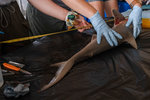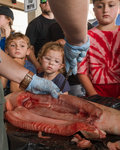Dozens of sharks. No, maybe hundreds? Were they headed to shore? Migrating? Was the water safe? Are there really sharks here?These are the questions social media users posted when a video surfaced …
This item is available in full to subscribers.
Please log in to continue |












Dozens of sharks. No, maybe hundreds? Were they headed to shore? Migrating? Was the water safe? Are there really sharks here?
These are the questions social media users posted when a video surfaced from Gulf Shores that captured a school of sharks easing their way through crystal clear Gulf waters.
Scientists at the Dauphin Island Sea Lab saw the video, too. Yes, that was a lot of sharks. Yes, it's completely normal. Yes, there are definitely sharks living in the Gulf. And yes, you might encounter one in very shallow water.
Sean Powers, who holds a Ph.D. and is director of the School of Marine and Environmental Sciences at the University of South Alabama and senior marine scientist at the Dauphin Island Sea Lab, said Alabama has a "healthy and diverse shark community."
The video posted to social media captured a school of blacktip sharks moving along the northern Gulf coast, he said, normal behavior for this time of year.
While many species are solo hunters, the blacktip prefers to hang out in packs, hunting schools of fish together. Around humans they have been known to be curious but timid and easily frightened away.
Most of the sharks that beachgoers in Alabama will see are of the smaller variety. Blacktip and bonnethead sharks reach a maximum of six feet while sharpnose, finetooth and blacknose sharks grow to just three to four feet long. Fishermen and sometimes swimmers will occasionally share their patch of ocean with any or all of these species and others that reside in deeper waters of the Gulf.
Mobile Bay acts as a nursery for many marine animals, including sharks, Powers said. The estuary there is tucked away from open water and provides sea animals a mix of fresh and saltwater. These protected spaces are safe for young animals to grow and thrive in and are a favorite stopping point for migratory birds during their long journeys. Estuaries are considered some of the most sensitive and ecologically important habitats on the planet.
As scientists are more successful at rebuilding the Gulf's shark population, which was once overfished and depleted, Powers said more humans will see and encounter them more often, especially as more visitors flock to the beaches.
Larger varieties of sharks do sometimes find their way to the shoreline. Young tiger and bull sharks have been seen in shallow waters, though their elders, which can reach 11 and 14 feet respectively, tend to stay in deeper water.
Though shark bites have happened in Alabama, they are rare. There have been only 12 reported shark bites in Alabama. The last happened in 2020 when a teen was bitten on the foot while swimming off of Orange Beach. The last fatal bite happened in 1894 in Mobile Bay.
The best way to avoid a shark encounter is to stay out of the water when purple flags are flown to indicate harmful marine animals. Powers also said swimmers should stay vigilant.
"Look around for fins and silhouettes," he said, "and for large splashing indicating smaller fish are being chased by predators."